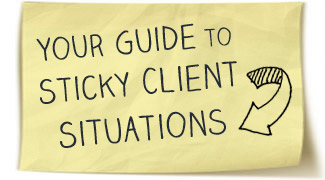
Do you know that crash and burn feeling when a relationship with a client is on the verge of ending?
It might start with them asking you for more and more work without upping your fee.
Or you have to wait three times as long to get urgently needed pieces of information from them.
Maybe they’ve just stopped liking any ideas you give them and you can’t figure out why.
Whatever the symptoms, the diagnosis is the same. It’s not healthy. It can’t continue. And you need to start looking to replace them.
Identifying Problem Clients Before They Become a Problem
Some future problem client warning signs are relatively universal. Problem clients respond to emails with several week delays. Getting the first payment from them is like pulling teeth in the Middle Ages. And they change the entire scope of your project at the last minute every time.
Unfortunately, a lot of problem clients are sneakier.
They seem perfect at first, loving your ideas, paying promptly, and making your feel appreciated. Then the six-month itch kicks in and things begin to go slowly awry.
For every self-employed woman, the process is a bit different, depending on your industry, the type of client you like, and what you’re willing to let slide.
Why Should You Weed Out Problem Clients Early On?
Successful self-employed women curate their client lists, not only to have a strong portfolio and work on challenging projects, but to keep their work sustainable.
When you’re just starting out, returning from having a new baby, or trying to replace the loss of a big client, it’s too easy to take any quick-paying work that comes along. And honestly, in those situations, that’s fine. When you need quick money, it’s more stressful to ignore that crucial fact and focus on long-term goals.
But you should never let those factors affect how you intake long-term clients.
You can use these techniques to evaluate potential new clients at any stage in the new client set-up process, but it’s best if you take a hard look at every potential long term client before you sign a binding contract.
Another good arrangement is to include a trial period in all of your on-going contracts that allows either party to leave without penalty at any point during the first 30 or 60 days. When you approach the end of the trial period, go through your list again and contemplate your experiences so far with the new client to see if they’re a keeper.
How to Create Your Own Client Pet Peeve List
(1) Pull Up Your Records on 3 Years of Past Clients
This might be your calendar, financial records, or a work tracking spreadsheet—whatever tool you have at your disposal that can remind you whom you’ve worked with.
If you’ve been in business less than three years, no problem. Work with what you have (and even think about your old boss at your full-time job if that’s applicable).
If you’ve been in business longer, you may have a better handle on this assignment. You’ve grown and chances are your portfolio, the type of work you do, and the clients you accept over time have evolved as well. In this case, there’s no need to go back much further.
(2) List Breakup Factors and Look for Trends
Look at each major client, whether for a large, intense project or a long-term relationship, and jot down a few notes on why the relationship ended.
If the project came to a close, why didn’t you work with them again? If you ended things because you wanted to raise your rates, were you feeling taken advantage of at their rates? Were they unwilling to pay what you were worth? Did that reflect in other behaviors?
If they suddenly ended the relationship due to lack of funding, were there warning signs early on that they didn’t have the funds to support your work?
(3) Describe Your Ideal Client Relationship
Take ten minutes and imagine your perfect client:
- the type of projects you’ll work on,
- what they’ll pay you,
- when they’ll pay you,
- how they’ll pay you,
- what administrative tasks are included in your fee,
- how they’ll correspond with you,
- how often they’ll correspond with,
- how you’ll exchange ideas,
- how you’ll decide on a project’s direction,
- how much you’ll charge for overages,
- how the client will accept work,
- how many revisions are permitted,
- what happens when the client doesn’t accept your work,
- how the relationship can end.
Think about including your preferences in your project proposals so that you are making sure to put them out there with every client.
(4) Determine What’s Missing in Your Current Relationships
Now that you’ve looked at what’s gone wrong in the past and what you would like for the future, turn to your current relationships.
You may know off the top of your head some things that some clients do that simply drive you crazy. Wish they would pay you without you having to send a reminder? Or let you know before they take a two-week email vacation? What makes you cringe and not want to open a client’s email? Or avoid replying for a day?
If you’re having trouble, walk through your ideal client vision with each of your major current clients to get the juices flowing on where they don’t quite line up and what factors into that gap.
(5) Make a Personal Checklist (with Client Intake Questions)
Take the most important traits that lead to your client break-ups, your needs for an ideal client relationship, and the key things that are missing with your current clients and create a set of questions to ask yourself and the client.
- Do they respond to emails promptly?
- Do they provide you with what you need when you need it?
- etc.
When you are discussing terms with a new long-term client, make sure each and every point gets addressed.
Don’t send them the questionnaire, but find information on their website if you can, sprinkle a few questions here and there in phone calls and initial emails, and observe their behavior.
BONUS: If You Like the Client, But See Warning Signs, Talk it Out
Sometimes it works and sometimes it doesn’t. One freelancer I spoke to had a long relationship with an editor who would often assign her stories after they were supposed to be due.
The freelancer brought it up at the end of their trial period, but it continued to occur sporadically until it brought about the end of their relationship.
Bring up any new concerns after you’ve worked with a new client for a month and see if they’re receptive to working together to fix the situation. If not, start looking to move on before the situation spirals out of control.
Photo: Source





